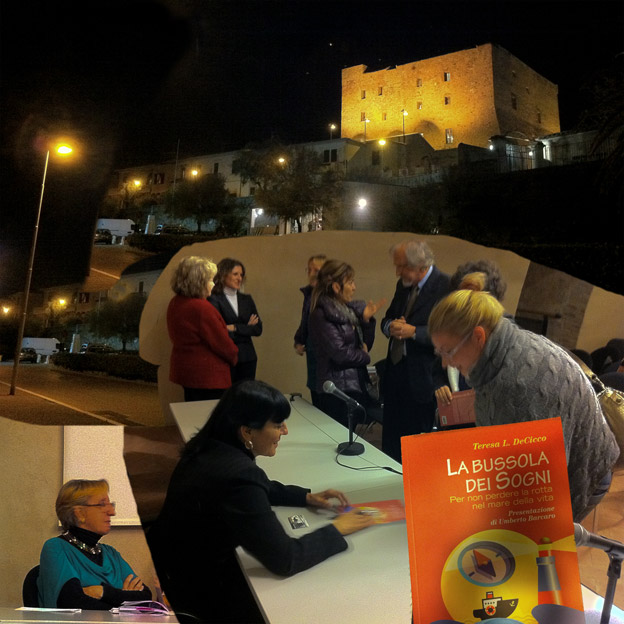It's nice to share our dreams and generally, people really like to tell others about their dreams. In fact, people have been sharing their dreams since the beginning of time. This being the case, dream sharing can be used in terms of formal dream interpretation. Many authors have used dream sharing in groups to help a dreamer find a link to waking life. Extending this previous work, The Projective Method of Dream Interpretation (DeCicco, 2007) was designed and then tested. The method has been used in groups with a specific protocol-it's easy to use and to teach. Also, the method has been scientifically tested and found to link to specific events in waking life. The method ensures safety and protects the dreamer's personal, private and confidential matters that may arise.
Sharing dreams in groups can provide discovery for the dreamer and also provides a space for group members to connect with each other. The method appears valuable to dreamers, workshop leaders, group therapy leaders and dream enthusiasts alike. After all, it is nice to share.
Thursday, March 26, 2009
Subscribe to:
Post Comments (Atom)


When the modern psychological study of dreams began, with Freud's psychoanalysis and Jung analytical psychology, the way to approach dreams was naturally consistent with the current scientific paradygm of the times. The use of the word "analisys" as if dreams were made of separated elements you could disconnect one from each other and then reconnect in different ways was absolutely consistent with a reductionist and mechanistic episthemology. Meanwhile Freud never abandoned the aim of building a "scientific" theory of mind, psychopathology and dreaming upon these basis, others like Jung or Frankl were drifting aside and followed other directions.
ReplyDeleteWhat I find provoking in Teresa's work is the narrativist set up of her method, which is consistent (but not prisoner,as I will state later on) with a narrative idea of mind that today has firmly settled in the instruments of many therapists and counsellors from different schools.
So far the narrativist paradygm has provided a lot of useful ideas, tools and changes for therapy; nevertheless it can be (in my opinion it must be) questioned from different points of view. One is the idea that you can replace a "bad" story with a "good" story. This is a stiff way to approach people's stories. In his personal criticism of this, a colleague of mine, Massimo Giuliani (Giuliani, Nascimbene: La terapia come ipertesto, 2009), outlines the idea of developing, instead, a "hypertextual", open, multiple context to exploit the virtualities of any story. I find this point of view really fertile but it risks to emphasize the "quantity" of points of view and openings as a sort of "holy well" where the new and creativity spring from. I see it instead as a very useful mean to perturb an distract our mind which always tends to closure, but the source of creativity, in my point of view, resides in suspensions and lapses of the discourse that this way are created. So I prefer to talk of a metanarrative, or creative approach that I use both in therapy and supervision. Giuliani and I discussed similarity and differences of our work in a workshop two years ago ("Il vento, le strade, terapia ipertestuale e narrativa", Manerbio,It. 2007).
A good resource of Theresa's method seems to be that it provides the opportunity of going in the directions featured above, that is having a narrative basis, a hypertextual group context, and eventually a metanarrative, or creative opportunity for the participant's minds.
Condividere e sostituire una “cattiva “ storia con una “buona” storia è ciò che , credo ,solo
ReplyDeleteil rapporto con l’altro può dare .
I vecchi dicevano: “Chi più ce ne ha , più ce ne metta “.
Penso che un gruppo abbia questo scopo : lo scambio di energie , per esempio attraverso le immagini di sogno . L’altra persona può “ ridarmi “ il sogno arricchito con immagini diverse e positive .
Mi sono resa conto del potere del gruppo specialmente quando , tanti anni fa , nel post –femminismo , tenevo un gruppo di donne . Queste donne erano talmente entrate l’un
nell’immaginario dell’altra che avevano conquistato il potere di far diventare una “ cattiva “
storia della sognatrice , una “buona “ storia .
These postings have brought up a very important aspect of the method that needs to be looked at in detail. That is, the actual "story" that is created with the method.
ReplyDeleteI began using the Ullman Method with my groups and then began condensing and restructuring the method. I tested the method for it's useability, psychometric properties, and it's ability to significantly lead to discovery. What has not been examined is what the "story" has to offer.
Several research assitants and students working on research projects with the method have commented on how rich and important the actual story seemed to be. Perhaps it is here that the method offers some real discovery and insight-whether a bad story or a good story-a valuable story no less.
I would appreciate some comments and suggestions as to how the story should be formally examined. Also, how can we use this portion of the method in the therapeutic process?
I thank-you for these very valuable comments in the blog.
A proposito di storie “buone” o “cattive”:, comunque “preziose” :
ReplyDeleteuna donna prima di una crisi psicotica sogna un gigantesco topo che la aggredisce in un letto di ospedale .
Io credo che se avesse avuto la possibilità di raccontare il suo sogno a persone interessate , e le altre persone glielo avessero poi rielaborato e “reso “ , forse
il sogno ugualmente non avrebbe avuto una bella fine, ma il topo non sarebbe stato così
gigante e avrebbe permesso al suo IO di difendersi .
La prevalenza dell’emozione di paura , terrore paralizzante…che il topo gigante esprime,
sarebbe stata senz’altro contenuta dalle proiezioni sul sogno del gruppo.
Il gruppo avrebbe permesso all’IO della sognatrice di vincere la battaglia.
First, Teresa asks:
ReplyDeletehow should be the story formally examined?
In my opinion this question does not have a simple answer considered that dreamworking is what we are talking about. The criteria that one can use with other kind of stories (like illness stories, healing stories, or life stories)do not fit with dreams in themselves, which are our starting point. Usually dreams are chaotic, contradictory, inconsistent with time and space. Or else, sometimes they are so trivial that you cannot consider them as if they were stories. Nevertheless ordinary criteria could fit with the stories that the group (and the individual) retrieves by taking the dream in account and working on it, in other words with the arrival point. This way one could decide how to consider the story produced by the group: e.g. whether as a master narrative or a counternarrative (Nelson 2001), or by telling the plot's type (Booker 2004), or, using Frank's categories as a restituion, or chaotic, or quest narrative. Finally one could decide to use criteria similar to those by Greenhalgh (2006)in the field of the narrative based medicine, and assess to which extent the story is attractive, consistent, plausible, persuasive, reportable.
One could decide to estimate the distance between the starting point and the final point. Or find a way to refer to White and Epston's work etc.
But I have to say that, as a therapist, I feel myself much more focused on the second question asked by Teresa:
how can we use this portion of the method in the therapeutic process?
This question connects directly the formal aspects of the considered narratives with a) the changes in the client's situation and b)the style and episthemology of the therapist who receives a new story from his client and from the group. This situation is similar to the one described in Donatella's example. She wishes that the group would return to the dreamer a more evolved story than the primitive one (following Werner's criteria, 1946) of her dream. In this case the group is deputizing Ego's functions (which is not only a cognitive issue, but also emotional and relational) and finally this all is consistent not only with the patient's needs but also with the therapist's episthemology.
Perhaps another therapist with a different approach could have different expectations.
So I would put Teresa's questions upside down.
As a therapist, what kind of output would I consider useful from a group dreamworking? And which kind of narrative would be consistent with this? And eventually, would groups produce this? I'm persuaded they do, and the aim of a research could be to clarify the whole process and discover how they do.
The group sharing methods that The Projective Method evolved from have proven to be effective in the therapeutic environment-so we know this method of dream interpretation works. In Donatella's example, had this dream been put to a group one would hope that the "mouse" in the bed would have emerged from the group as a warning or as fear arising for the dreamer. This could have pushed the real issues from the unconscious into the concious mind, which is the work we do in therapy. It seems that the group sharing is a very effective way of pushing unwanted, rejected or repressed material into conscious awareness for the dreamer.
ReplyDeleteIn testing a similar method from which The Projective Method Evolved from (DeCicco,2007)it was found that waking day issues show up in discovery from this method. For example, people with relationship issues discovery something about their relationship. People with waking day health issues discover something about their health. The continuity hypothesis was confirmed in the dream imagery itself but also in the discovery from the dream. Further testing should expand on Massimo's suggestion-what kind of output is useful for the therapist and patient? Perhaps using the method with a homogeneous group (e.g. all with anxiety disorders)and analyzing the discovery passages would shed some light into this process.